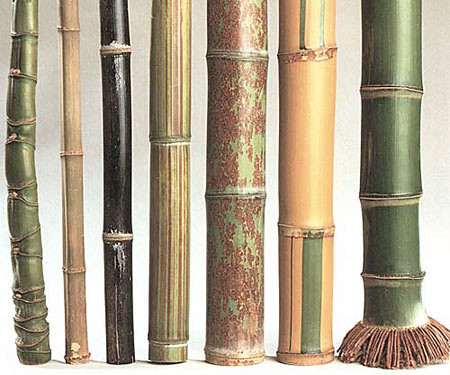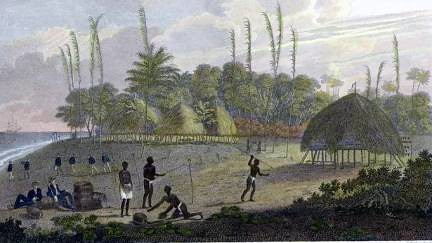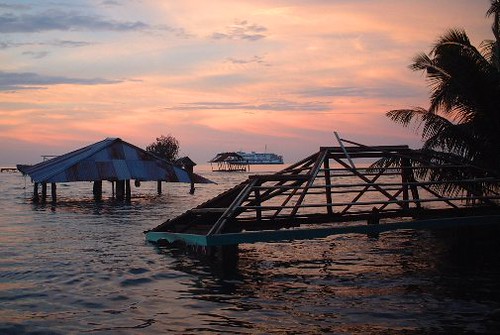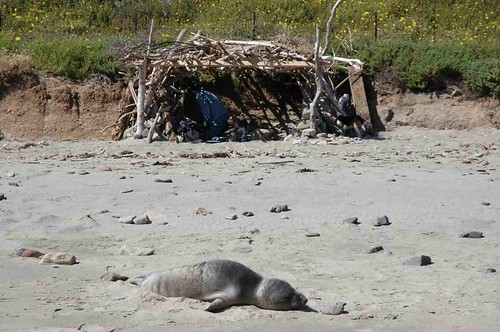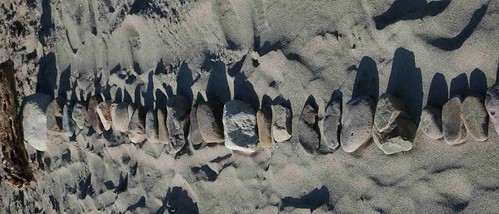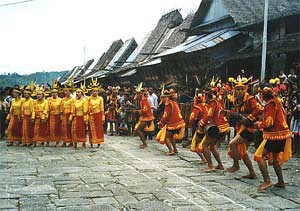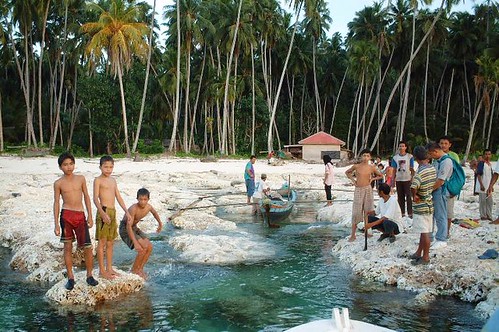Bamboo Central
ENVIRONMENTAL BAMBOO FOUNDATION
The Bamboo Nursery: With the help of LIPI's Dr. Elizabeth Widjaja and INBAR, EBF maintains a growing nursery to meet current and future needs for various planting projects. Started with eighty species of bamboo, EBF has successfully propagated more than 35,000 seedlings. While ensuring the propagation of all species, particular emphasis has been given to those most suitable for timber, shoot production and landscaping.
Where We've Been Where We Are Now Where We Are Going
HISTORY OF THE FOUNDATION
The Environmental Bamboo Foundation (EBF) is an Indonesian non-profit organization founded by designer Linda Garland in 1993 to protect tropical forests by promoting and demonstrating the many conservation and development opportunities that bamboo offers. In less than three years EBF has helped put bamboo on the conservation and development agenda of Indonesia while generating an international interest in bamboo that's growing exponentially. EBF, based in Bali, Indonesia has affiliate non-profit organizations in America (IBF), and Holland, also dedicated to spreading the news about bamboo.
The EBF has a focus upon international development, through consulting and education, preservation research, agro forestry projects, watershed reclamation, plantation development and policy development. Weekly educational workshops under the guidance of the staff of the Environmental Bamboo Foundation are ongoing in Indonesia. To date, all EBFand IBF board members have volunteered their time and resources to promote bamboo as an environmental solution. The EBF works in concert with the International Bamboo Foundation, the Zeri Foundation and an international network of bamboo associations, scientists, universities and governments.
EBF's main activities include:
* Design and marketing of locally produced, high quality bamboo products.
* Education and training in all aspects of bamboo production, from planting to marketing.
* Bamboo-based agro forestry and watershed rehabilitation.
* Applied research, information gathering and dissemination.
* Networking with government officials, entrepreneurs and bamboo experts.
EBF works in collaboration with:
* The Indonesian Government at national, provincial, district, sub-district, and village levels.
* International, national, and regional NGO's.
* International and national higher education and research institutions.
* Community groups.
* Private-sector entrepreneurs.
* Bamboo specialists from around the world.
WHERE WE'VE BEEN ...
The IVth IBC:
In 1995 the EBF hosted the IVth International Bamboo Congress, architectural forum, trade show and music festival in Bali, Indonesia. This four day world class environmental event drew over 2000 attendees from 37 countries. For the first time, the world's leading scientists, business representatives, engineers, architects, environmentalists and politicians participated together to promote bamboo as an environmental solution. This event was covered in Indonesia by CNN's Elsa Klench...
It was a landmark event when Indonesian Minister of the Environment, Sarwono
Kusumaatmadja, who officiated at the opening of the Congress, committed Indonesia to the "Zero Emissions" policy, after meeting with Gunter Pauli, co-author with Fritjof Capra of "Steering Business Towards Sustainability". In partnership with the IBF and EBF , Mr. Pauli, has since gone on to found ZERI (Zero Emissions Research Initiative). This effort has now created standards for industrial reform worldwide of the recycling of waste and reduction of CO2 emissions. This event was one example of the diverse range of environmental solutions explored and launched at the conference.
Training Center at Penglipuran:
In 1994 a fully equipped training center , surrounded by bamboo gardens and nurseries, was created in Penglipuran. Its facilities include classrooms, workshops, an office, a dormitory, and a kitchen. Equipment at the center includes basic tools and machines for bamboo preservation and making ply-bamboo. The Center is managed cooperatively with the Penglipuan community, who contributed land and labor for its construction. Funding for this project came from a grant from USAID and the Earth Love Fund (UK).
Training Indonesia's First Group of Bamboo Trainers
In early 1995 the Bamboo Training Center in Penglipuran hosted thirty people from NGOs and government agencies in Indonesia, who were trained in all aspects of bamboo cultivation, production, and marketing. After the program, participants returned home with locality specific bamboo action plans including agro forestry and watershed protection, as well as production and marketing of bamboo products. EBF intends to provide continued technical and marketing support to this first group of trainers, as well as to training of an additional group in 1996.
Supporting Indonesia's National Bamboo Development Strategy
As a direct result of the IVth International Bamboo Congress, Festival and Trade Show, the Government of Indonesia's commitment to bamboo for conservation and development has been solidified. In late 1995, bamboo was declared a multi-purpose species, thus opening the way to research and development for bamboo applications in the Departments of Agriculture and Forestry. In February 1996, the government initiated the National Bamboo Development Strategy, coordinated by the Ministry of the Environment and Department of Forestry, including representatives from nine Ministries and Departments. EBF is pleased to have been invited to take an active role in the implementation of Indonesia's National Bamboo Development Strategy Program.
WHERE WE ARE NOW...
Establishment of Bamboo Based Agro forestry Projects
The EBF has initiated three bamboo based agro forestry projects in Bali. One site is located ion community land managed through traditional community institutions (Tanah Adat), and is operated both as a producing plantation and as a demonstration plot in cooperation with local farmers. The second project is located on degraded forestland and is managed in collaboration with the Department of Forestry. Active on these projects are scientists from the Indonesian Institute of Science (LIPI), Udayana University professors and students, government officials at the national, provincial and local level, representatives from Indonesian NGO's and community groups.
These seemingly modest projects far reaching effects have already fostered:
* Formation of a special team of Indonesian scientists who will develop onsite applied research to extensive bamboo cultivation throughout Indonesia.
* Training opportunities for government and NGO field workers, and local farmers who are learning new techniques adaptable for other areas
* Generation of Indonesia's first set of comprehensive data (to be completed within five years) to support the overall expansion of bamboo production throughout Indonesia.
WHERE WE'RE GOING ...
Boucherie Bamboo Preservation
The powder post beetle continues to inhibit the potential of bamboo export market development. In collaboration with Professor Walter Liese, an EBF board member and the world's leading expert in bamboo processing, EBF has developed a treatment process that eliminates this problem by replacing the sweet sap in bamboo with an eco-friendly preservative that repels insects. This year, we will continue researching the viability of this system and develop a prototype that can be used by entrepreneurs for income generation in through out Indonesia and internationally. Concurrently, the EBF will train NGO's community groups and entrepreneurs interested in establishing their own treatment facilities. Finally in collaboration with the Penglipuran community, EBF will begin selling treated bamboo in order to demonstrate the feasibility of the Boucherie process as a distinct business and to generate revenues to sustain the foundations work.
The Bali Nursery and Collection Garden
EBF is working with the Government of Indonesia to establish Bali's Bamboo Collection Garden, one of seven such gardens to be set up across the nation to conserve bamboo stock, provide research and education opportunities, promote ecotourism, and generate income from a visitor's entrance fee as well as from the sale of bamboo plants. The Bali Bamboo Collection Garden will be established at the EBF Training Center in Penglipuran and will eventually include species traded from six other Indonesian collection gardens.
Charitable Contributions are acknowledged by a receipt for tax deductions over USD$300 Thank you for your support
EBF - Bali P.O. BOX 196, Ubud, Bali Indonesia 80571 Phone: 62 361 974 028 Fax: 62 361 974 029
